Dasburg-Prum River Campaign |
|
(TBD) |
|
|
Chapter VI |
Dasburg-Prum River Campaign |
|
(TBD) |
|
|
Chapter VI |
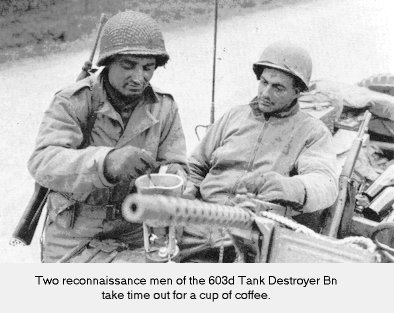
On 20 March, about 1000A, the German line gave way and the armored exploitation began. By the end of the day, the Division had five thrusts driving into Germany. Combat Command B on the right passed through the 3rd Infantry Division front lines then split into two columns at ZWEIBRUCKEN advancing to the northeast. Following closely behind was Reserve Command. The 86th Cavalry Reconnaissance Squadron Mechanized, reinforced, composed the center thrust, breaking through the 45th Infantry Division line at EINOD on LES BLIES River. Attacking on the left at ENSHEIM were Combat Command A's two columns, which had been attached to the XXI Corps, 19 March, because of the evident breakthrough by the 63rd Infantry Division on that Corps front. The command reverted to Division control immediately after passing through the XXI Corps line.
Jumping off at noon, 20 March, Combat Command A sped rapidly in two
columns through light disorganized resistance. The brunt of the resistance,
felt by the advance parties, was soon destroyed or routed, permitting the
main body of the columns to pass without delay. Throughout the day
the towns of KLEINOTT, WEILER, JAGERSBURG, KUBELBERG, and SCHONEBURG had
fallen to the speeding columns.
With less speed than the left column, Combat Command B drove through
heavy enemy resistance north of WEISSERHUBEL, destroying antitank guns,
medium artillery pieces, and capturing many prisoners. After continuing
the march into MORSBACH and KASHOFFEN, one of the forces of the command
had a heavy fight at ROZENKOPP. A more determined enemy in the second
line of SIEGFRIED defenses was encountered by Combat Command B's columns.
Enemy rear guard action caused only short delays until the resistance could
be run down or bypassed. An enemy ambush was almost successful in
cutting off a portion of the Combat Command B left column, but after bitter
fighting the small force fought off its attackers and hurriedly raced to
rejoin the main body of the column at KASHOFEN. After almost 36 hours
of hard hitting through German held towns and villages, including RANSTEIN,
RODENBACH, OTTERBACH, NEUKIRCHEN, WINTERBACH, LANDSTUHL, MEHLINGEN and
RAMSEN, the columns reached EBERTSHEIM.
Bypassing HOMBURG at 2030A, 20 March, because of a large enemy force
reported there, Combat Command A's column continued north. First
contact with Third U. S. Army troops advancing from the MOSELLE River was
made with the 26th Infantry Division on 20 March at LANDSTUHL. After
swinging east, the parallel columns of Combat Command A rapidly moved into
and captured DRIESEN and OSTHOFEN. By 1200 21 March, Combat Command
A had a force on the west bank of the RHINE River in RHINE-DURKHEIM --
the only town on the RHINE captured by XV Corps troops. At 0900 that
morning patrols had gone into WORMS and contacted Third U. S. Army forces
in that
city.
6th Armored Division troops patrolled the west bank of the RHINE River
in the vicinity of RHINEDURKHEIM until 21 March when 3rd and 45th Infantry
Division elements relieved them. On this date the 6th Armored was
assigned to the XII Corps, Third U. S. Army. After word was received
of the three Allied bridgeheads across the RHINE River, it was sensed by
the officers and men of the Division that the final phase of the European
War was at hand. The 6th's armored columns would fully contribute
to that last chapter.
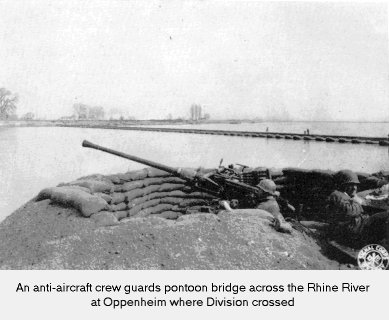 The 6th
Armored Division assembled near DEXHEIM and then crossed the RHINE River
at OPPENHEIM, passing through the 5th and 90th Divisions' bridgehead.
The entire Division cleared the single pontoon bridge there in
The 6th
Armored Division assembled near DEXHEIM and then crossed the RHINE River
at OPPENHEIM, passing through the 5th and 90th Divisions' bridgehead.
The entire Division cleared the single pontoon bridge there in
light enemy resistance, consisting of small arms, bazooka and some light
artillery fire. By nightfall, Combat Command A had reached the MAIN
River between RUSSELSHEIM and RAUNHEIM. Combat Command B bypassed
heavy resistance at MORFELDEN and raced northeast, going into assembly
south of WALLDORF, making contact with Combat Command A on the left, and
elements of the 90th Infantry Division on the right near LANGEN.
Before reaching the MAIN River, Combat Command B captured LANGER and SPRENDLINGEN, fought its way against heavy antitank fire along the SPRENGLINGEN-NEW-ISENBERG road, and attacked OFFENBACH from two directions. Resistance was surprisingly shallow, and the town fell by 1500, 26 March.
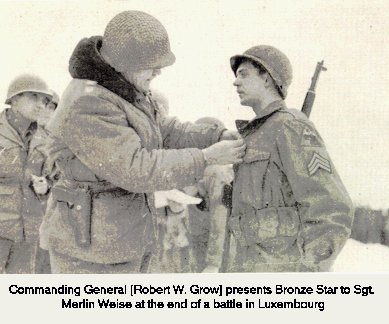 Immediately
upon reaching NIEDERRAD, Combat Command A sent patrols to the MAIN to find
a crossing. A partially destroyed bridge was found, and a company
of armored infantry, dismounted, was alerted to secure the north shore.
Tanks were rushed up on the south shore to cover, by fire, the infantry
crossing. Small waves of infantry assaulted the opposite shore against
heavy machine gun and antitank fire.
Immediately
upon reaching NIEDERRAD, Combat Command A sent patrols to the MAIN to find
a crossing. A partially destroyed bridge was found, and a company
of armored infantry, dismounted, was alerted to secure the north shore.
Tanks were rushed up on the south shore to cover, by fire, the infantry
crossing. Small waves of infantry assaulted the opposite shore against
heavy machine gun and antitank fire.
Upon reaching the FRANKFURT river bank at 1630, 26 March, the
small group commenced to clear out and secure their little bridgehead,
the first one to be established in FRANKFURT. Additional troops were
summoned to reinforce the troops in the bridgehead. Before this force
could be assembled to cross the river, the enemy unleashed a barrage of
artillery (all calibers), dual purpose antiaircraft guns, heavy mortars
and volleys of small arms, the like of which the Division had never witnessed
since it had been in combat. The German fury was directed on the
partially destroyed bridge, in an effort to prevent reinforcement of the
bridgehead. In spite of the heavy fire, armored foot-troops continued
to pour on the opposite bank into FRANKFURT. The shelling made it
impossible to repair the bridge, preventing a vehicular crossing to support
the foot-troops.
On 28 March, orders were received to cross the MAIN River at the 90th
Infantry Division bridge at DRONIGSHEIM. By late afternoon of the
same day the Division's columns cleared the bridge and advanced north and
northwest.
CARTE, WEITERSSHAIN, ZENNERH, and many more towns displayed white flags as the 6th Armored Division rolled through. The days' action was marked by an exceptionally large number of German prisoners and a large number of uncovered Allied prisoners.
Within 24 hours a second change of orders relieved the Division from the KASSEL mission, and sent it to the east to attack in the direction of WEIMAR. This had been anticipated on 30 March when the Corps Commander met the Division Commander and directed that KASSEL be captured unless resistance proved too great, in which case authority was given to cut east across the FULDA River south of KASSEL. This was done, and the mission of capturing KASSEL was given to the 80th Infantry Division.
Nazi government offices were believed moved into the WEIMAR area, and a quick thrust, it was believed, would result in the-ir capture. Now under XX Corps control, the Division resumed pursuit of the enemy to the east with Combat Command A on the left and Combat Command B on the southern flank (right).
Greatest of the delays to the Division were blown bridges, detonated by the fleeing enemy. Only after long reconnaissance, costly bridgeheads were secured and tiring bridge-building tasks were necessary to enable the commands to cross the FULDA, WEHRE and WERRA Rivers. These delays permitted the Division's columns to advance only 45 miles on the 1st, 2nd, and 3rd of April.
Once the WERRA River was spanned, 4 April, the Division's columns fanned out to encircle the city of MUHLHAUSEN which lay ahead. Elements of Combat Command B advanced on the city from the southwest, south, and southeast, while troops from Combat Command A swept far to the north to encircle and attack MUHLHAUSEN from the north, west, and northeast. In conjunction with the assault on MUHLHAUSEN, a tank force from Combat Command B was to spearhead to the east and capture SCHLOTHEIM, cutting off any enemy element attempting to assist the trappe troops in MUHLHAUSEN.
Preceded by patrols, the main force entered MUHLHAUSEN under darkness 4 April. Coordinated, the armored vise closed on the city. Offering practically no resistance, the German garrison surrendered and the city was cleared by, 0905B, 5 April. Reserve Command was given the task of maintaining law and order and guarding all installations and supply stores in the city.
Resuming the march to the east, Combat Command A entered the city of LANGENSALZA in the afternoon of 5 April. After a series of roadblocks and light enemy resistance within the city, the tankinfantry teams cleared the defenders by noon the following day. While this action was occuring, Combat Command B was deployed in the MUHLHAUSEN sector, limiting its -activity to light patrols to the north and east. On the 5th both commands established a line of 40 miles length to the north and east of their respective captured cities and began a reorganization and refitting program, prevented from further advance by Corps order pending the arrival of the First U. S. Army on the north flank.
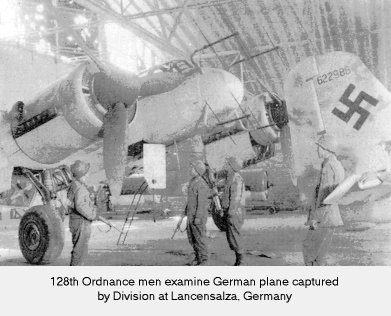 On 7
April Reserve Command was sent to the west to relieve pressure on the 76th
Infantry Division and the 3rd Cavalry Group which were still on the WERRA
River held up by a pocket of heavily armed enemy troops. After two
days of
On 7
April Reserve Command was sent to the west to relieve pressure on the 76th
Infantry Division and the 3rd Cavalry Group which were still on the WERRA
River held up by a pocket of heavily armed enemy troops. After two
days of
heavy fighting the German pocket was finally dissolved and contact
was made with the troops of the 76th Infantry Division and elements of
the 3rd Cavalry Group. Enemy who had been opposing the 76th Infantry Division
along the WERRA River began withdrawal during the night 6-7 April in the
direction of MUHLHAUSEN. Before daylight, this enemy force of considerable
strength attacked the 3rd Battalion, 261st Infantry at STRUTH and threatened
to defeat it.
Information that 86th CC Trains in STRUTH were overrun reached Division
Headquarters at 0730. Fortunately, a Battalion of the 304th Infantry,
mounted in trucks, was on the road just southeast of MUHLHAUSEN, and reinforced
by a company combat team of the 69th Tank Battalion, the Battalion was
rushed west and restored the situation at STRUTH. Contact was also
made with ReservE, Command further northwest. The enemy force of
about 1,500 troops reinforced by tanks and selfpropelled guns was completely
destroyed. The town of STRUTH, practically untouched up until this
counterattack, was almost totally destroyed in the fight.
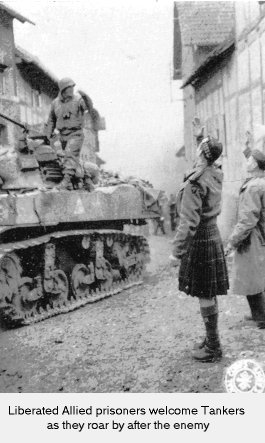 Anxious
to return to the attack, after six days of comparative inactivity, the
tank-infantry forces rolled forward on 11 April, moving rapidly through
the 76th Infantry Division and by nightfall the Division had travelled
60 miles. Resistance was moderate, consisting mostly of small isolated
pockets of enemy infantry bazooka teams defending the towns and villages
dotting the roadside. During the day's operations many German installations
were captured, a large Allied Prisoner of War camp near BAD
SULZA had been liberated as well as 21,000 inmates of the infamous German
concentration camp, BUCHENWALD, north of WEIMAR. Bridges across the
SAALE River near CAMBURG and KLEINHEIRGER were captured at sundown.
Anxious
to return to the attack, after six days of comparative inactivity, the
tank-infantry forces rolled forward on 11 April, moving rapidly through
the 76th Infantry Division and by nightfall the Division had travelled
60 miles. Resistance was moderate, consisting mostly of small isolated
pockets of enemy infantry bazooka teams defending the towns and villages
dotting the roadside. During the day's operations many German installations
were captured, a large Allied Prisoner of War camp near BAD
SULZA had been liberated as well as 21,000 inmates of the infamous German
concentration camp, BUCHENWALD, north of WEIMAR. Bridges across the
SAALE River near CAMBURG and KLEINHEIRGER were captured at sundown.
The multiple columns of the Division rolled on and were not stopped until they were met by extreme fire from the antiaircraft defenses of the ZEITZ-LEIPZIG line in the vicinity of DROYSSIG, 12 April. Combat Command B was instructed to bypass the city of ZEITZ, close by, and circle north, while Combat Command A was to swing south on a bypass. Reserve Command, reinforced, was committed on a frontal attack to secure a bridge across the WEISSE-ELSTER River in the city of ZEITZ.
By midnight forward elements of Reserve Command were in the outer zone of the city's defenses. Bypassed enemy groups and antiaircraft installations slowed the advance. By early morning, 13 April, as Reserve Command elements were attempting to seize the northern bridge, it was blown before them. Simultaneously, the other two bridges in the city were destroyed. A bridgehead was established in ZEITZ, but enemy direct fire weapons prevented the construction of a bridge, restricting vehicular crossing. The small party in the city was soon reinforced and after 24 hours of. continuous street fighting ZEITZ was cleared, and the antiaircraft installations were silenced. In the meantime Combat Command B to the north of the city and Combat Command A to the south had forced crossings and in brilliantly executed attacks with strong air cooperation knocked out over 100 large caliber dualpurpose AA guns.
The Division's attack to the east continued against stubborn but isolated
enemy action. After clearing the zone of the dual-purpose 88mrn weapons
and blown bridges around ZEITZ the three commands came abreast upon the
Corps limiting line 15 April, at the ZACHOPAU River with Reserve Command
at the southern sector with Combat Command A's elements in MITTWEIDA.
The 9th Armored Division having followed Combat Command B through PEGAU
came upon the Division's left rear, while the 76th Infantry Division which
had followed from LANGENSALZA had the sector to the south. Except.for
a few outposts on the eastern shore of the ZACHOPAU River, the 6th Armored
Division remained deployed on the west banks. On this date the Division
passed from XX Corps control to that of the VIII Corps. Aggressive
patrolling was maintained by each command to the east in an effort to survey
enemy activity, and to watch for a possible contact with the rapidly advancing
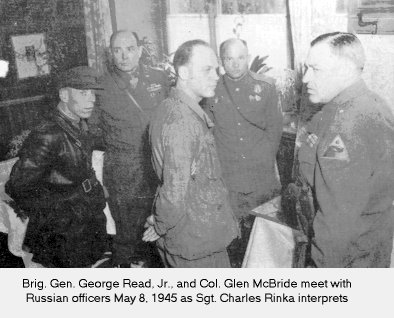 Russian
Armies driving west. Further advance was prohibited by Corps order.
So ended the fight for most of the men in the 6th Armored Division.
Russian
Armies driving west. Further advance was prohibited by Corps order.
So ended the fight for most of the men in the 6th Armored Division.
From the 18th of April until the termination of the war with Germany on midnight, 8 May, the Division was engaged in Military Government activities along the front recently captured and to a depth of 60 miles.
The campaign from the RHINE to the ZACHOPAU River, a distance of 275 miles, was a perfect example of exploitation. Enemy in sufficient strength to completely block the Division was met regularly and frequently, but in no case was the enemy allowed to have time to deploy, to employ his guns, to maneuver, to place his demolitions or in any way to organize a sizeable delaying force. The only delays of any consequence were caused by permanently emplaced dual-purpose antiaircraft guns in the industrial areas and the long prepared demolitions at major stream crossings.
Many memories will be carried off by the officers and men of the 6th Armored Division in its operations in Germany, but among the most vivid will be the four lanes of armored traffic racing up the Autobahn on 29 March into the heart of Germany, with streams of broken and tired German soldiers trudging to PW enclosures in the opposite direction, between the concrete strips of highway. Later, in the early days of April, the Division's six columns deploying as they flowed across the rolling plains of THURINGIA and SAXONY, engulfing the cities and pockets of resistance formed a picture that would gladden the heart of any mounted soldier. Weather was almost perfect and the terrain admitted mounted maneuver at will. This major operation of spanning the breadth of Germany in 22 days was one that was fitting to the termination of a war in which the 6th Armored Division had fought under most difficult and trying conditions.
Dasburg-Prum River Campaign |
|
(TBD) |
![]() Return
to 6th Armored home page.
Return
to 6th Armored home page.
NOTE: Remove question mark from email address below when sending email.
Page maintained by Bruce
Frederick
Last update: May 17, 1998 ![]()